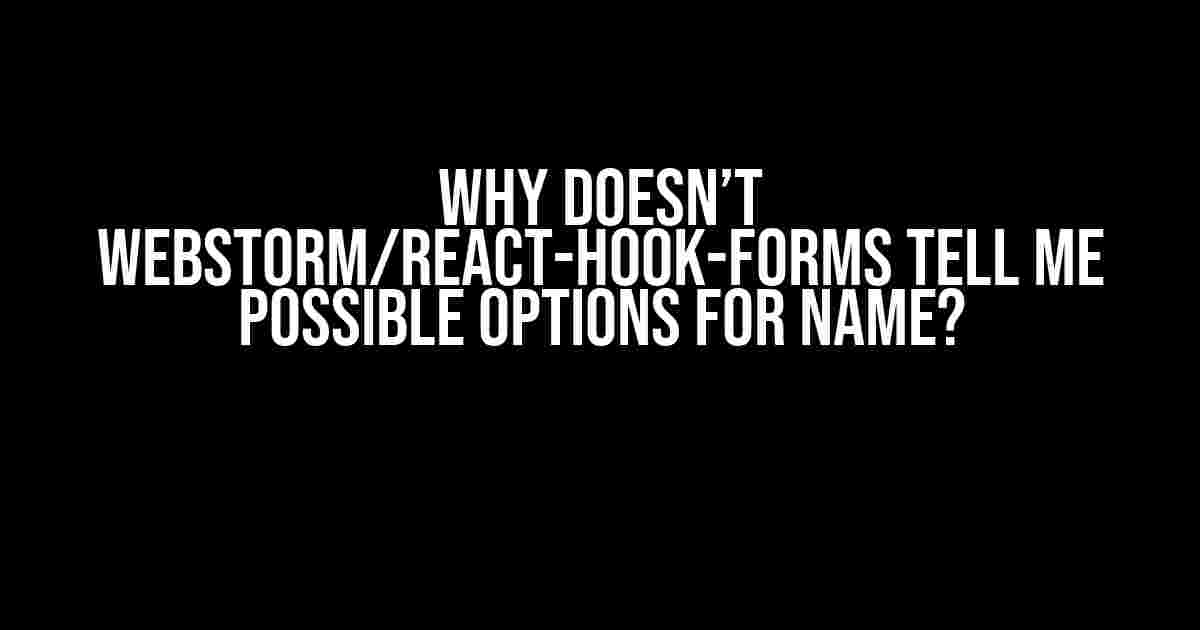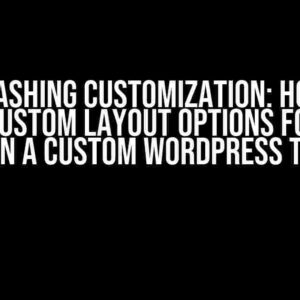Have you ever found yourself scratching your head, wondering why WebStorm or React-Hook-Forms isn’t suggesting possible options for the `name` prop in your React application? You’re not alone! In this article, we’ll dive into the reasons behind this behavior and provide you with solutions to get those suggestions flowing again.
Understanding the Issue
Before we begin, let’s take a step back and understand why this issue might be occurring in the first place. When you type `name=` in your React component, WebStorm and React-Hook-Forms rely on their respective intellisense engines to provide you with possible options. However, in some cases, these engines might not have enough information to suggest the correct options.
Reason 1: Lack of Type Definitions
One common reason for this issue is the absence of type definitions for your React components. Without type definitions, WebStorm and React-Hook-Forms can’t accurately determine the possible options for the `name` prop.
To resolve this, make sure you have the `@types/react` package installed in your project. You can do this by running the following command in your terminal:
npm install --save-dev @types/reactIf you’re using yarn, use the following command instead:
yarn add @types/react --devReason 2: Missing Prop Type Definitions
Another reason for this issue is the absence of prop type definitions for your React components. Prop type definitions provide essential information about the props accepted by your components, including the `name` prop.
To resolve this, you need to add prop type definitions to your React components. For example, let’s say you have a `MyInput` component that accepts a `name` prop:
import React from 'react';
interface MyInputProps {
name: string;
}
const MyInput: React.FC<MyInputProps> = ({ name }) => {
return <input type="text" name={name} />;
};In this example, we’ve added a `MyInputProps` interface that defines the `name` prop as a string. This provides WebStorm and React-Hook-Forms with the necessary information to suggest possible options for the `name` prop.
Reason 3: Incorrect Folder Structure
Believe it or not, your folder structure can also affect the intellisense behavior in WebStorm and React-Hook-Forms. If your React components are not correctly organized within your project, the intellisense engines might struggle to find the necessary type information.
To resolve this, make sure your React components are organized within a logical folder structure. For example, you can create a `components` folder within your project and place your React components inside it:
project/
components/
MyInput.tsx
...
index.tsx
...
package.json
Solutions
Now that we’ve covered the reasons behind this issue, let’s explore some solutions to get those suggestions flowing again:
Solution 1: Enable Intellisense for React-Hook-Forms
If you’re using React-Hook-Forms, you need to enable intellisense support in your `react-hook-forms` configuration. You can do this by adding the following code to your `react-hook-forms` config file:
import { configure } from 'react-hook-form';
configure({
// Enable intellisense support
intellisense: true,
});This will enable intellisense support for React-Hook-Forms, which should provide you with suggestions for the `name` prop.
Solution 2: Use the `displayName` Property
Another solution is to use the `displayName` property in your React components. The `displayName` property provides a string value that identifies your component, which can help WebStorm and React-Hook-Forms understand the component’s identity and provide suggestions for the `name` prop.
import React from 'react';
const MyInput = ({ name }) => {
return <input type="text" name={name} />;
};
MyInput.displayName = 'MyInput';In this example, we’ve added the `displayName` property to the `MyInput` component, which provides a string value that identifies the component. This should help WebStorm and React-Hook-Forms understand the component’s identity and provide suggestions for the `name` prop.
Solution 3: Use a TypeChecker
A type checker like TypeScript can help WebStorm and React-Hook-Forms understand the type information of your React components, which can enable suggestions for the `name` prop.
To use a type checker, you’ll need to install TypeScript in your project:
npm install --save-dev typescriptNext, create a `tsconfig.json` file in your project root with the following configuration:
{
"compilerOptions": {
"outDir": "build",
"sourceMap": true,
"noImplicitAny": true,
"moduleResolution": "node",
"esModuleInterop": true,
"allowSyntheticDefaultImports": true
}
}This configuration tells TypeScript to compile your code and generate type information. This should enable suggestions for the `name` prop in WebStorm and React-Hook-Forms.
Conclusion
In this article, we’ve explored the reasons behind why WebStorm and React-Hook-Forms might not be suggesting possible options for the `name` prop in your React application. We’ve also covered several solutions to resolve this issue, including enabling intellisense support, using the `displayName` property, and utilizing a type checker like TypeScript.
By following these solutions, you should be able to get those suggestions flowing again and improve your development experience with WebStorm and React-Hook-Forms.
FAQs
Q: Why doesn’t WebStorm suggest possible options for the `name` prop?
A: WebStorm might not suggest possible options for the `name` prop if it lacks type definitions for your React components or if your folder structure is incorrect.
Q: How can I enable intellisense support for React-Hook-Forms?
A: You can enable intellisense support for React-Hook-Forms by adding the `intellisense: true` configuration option to your `react-hook-forms` config file.
Q: What is the `displayName` property?
A: The `displayName` property provides a string value that identifies your React component, which can help WebStorm and React-Hook-Forms understand the component’s identity and provide suggestions for the `name` prop.
Q: How can I use a type checker like TypeScript?
A: You can use a type checker like TypeScript by installing it in your project and creating a `tsconfig.json` file with the necessary configuration options.
| Solution | Description |
|---|---|
| Enable Intellisense for React-Hook-Forms | Enable intellisense support for React-Hook-Forms by adding the `intellisense: true` configuration option. |
| Use the `displayName` Property | Use the `displayName` property to provide a string value that identifies your React component. |
| Use a TypeChecker | Use a type checker like TypeScript to enable suggestions for the `name` prop. |
Frequently Asked Question
Get the inside scoop on why WebStorm and React Hook Forms aren’t giving you the name options you need!
Why doesn’t WebStorm provide auto-complete suggestions for the “name” attribute in React Hook Forms?
WebStorm relies on the project’s configuration and settings to provide auto-complete suggestions. If the “name” attribute is not explicitly defined in your React Hook Form component, WebStorm might not be able to infer the possible options. Try checking your project settings and making sure you’ve installed the necessary plugins for React Hook Forms support.
Is it a limitation of WebStorm or React Hook Forms that prevents it from suggesting “name” attribute options?
It’s not exactly a limitation, but rather a combination of how WebStorm and React Hook Forms work together. WebStorm needs explicit type definitions to provide accurate auto-complete suggestions, while React Hook Forms relies on the developer to define the “name” attribute explicitly. By providing clear type definitions and following best practices, you can improve the auto-complete experience in WebStorm.
How can I improve auto-complete suggestions for the “name” attribute in React Hook Forms with WebStorm?
To improve auto-complete suggestions, make sure you’ve installed the necessary plugins for React Hook Forms support in WebStorm. Additionally, use explicit type definitions for your form fields, and define the “name” attribute clearly in your React Hook Form component. This will help WebStorm provide more accurate and relevant auto-complete suggestions.
Are there any workarounds to get WebStorm to suggest “name” attribute options for React Hook Forms?
One workaround is to define an interface or type for your form fields and include the “name” attribute in that definition. This will help WebStorm understand the structure of your form fields and provide more accurate auto-complete suggestions. You can also try using the “any” type as a placeholder until you define the explicit type definition.
Will future versions of WebStorm or React Hook Forms improve auto-complete suggestions for the “name” attribute?
Both WebStorm and React Hook Forms teams are constantly working to improve their respective tools. While there’s no concrete timeline for this specific feature, it’s likely that future updates will include enhancements to auto-complete suggestions for the “name” attribute. Keep an eye on the release notes and changelogs to stay in the loop!



